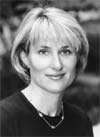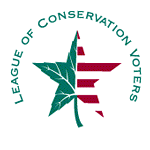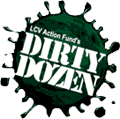Deb Callahan is president of the League of Conservation Voters, based in Washington, D.C.

Monday, 23 Oct 2000
LOS ANGELES, Calif.
So, here I am writing a week of diaries for Grist Magazine to publish online. On the one hand, I’ll enjoy sharing my crazy week with Grist’s readers (I’m an avid Grist fan myself.) On the other hand, how can I possibly convey the election electricity, intensity, and unpredictability that pervades each day? Oh well, here goes nothing.

Today I traveled to Los Angeles so I can conduct the West Coast press conference to release the League of Conservation Voters’ 2000 National Environmental Scorecard. It’s amazing to think that this is the 30th year that LCV is releasing the Scorecard, which has become the standard for rating members of Congress on their performance on environmental issues.
Scorecard releases are a big deal at LCV. The national release press conference will be held in Washington, D.C., and C-SPAN will cover it live. This year, we also sent out approximately 150 local press releases throughout the country, and grassroots organizations are distributing about 40 state-specific releases nationwide. The old adage that “all politics are local” holds true for environmental politics, and the more we can get our information out to local news outlets, the more we influence politics. Check out the Scorecard to see how your representative did in Congress this year on key environmental votes.
This week will be full of a variety of events, each of which demands substantial preparation. For the Scorecard release on Tuesday, I’ll have to study the California scores, learn the details of the 21 votes we are grading the members on, review and edit my press statement and the press release, and think about potential answers to questions I may face.

Steve Kuykendall.
On Wednesday, I will be doing press events in Los Angeles to expose the anti-environmental voting records of two of our Dirty Dozen targets: Reps. Steve Kuykendall and Jim Rogan. I have separate briefing books for each of those campaigns, and each briefing book contains relevant opposition research, environmental voting history and positions, internal LCV polls and other public polling information, candidate profiles, press information, scripts for ads we’re running, background sheets on state and local environmental issues, and a host of other information. It’s a lot of data to digest and retain, and I make sure to review my briefing books before every Dirty Dozen or Environmental Champions event that I do, especially those that involve press. Sometimes I think we might as well be running a presidential campaign, because our campaigns involve that level of breadth and complexity.

Jim Rogan.
I think it’s important for these events to be successful, because both the Kuykendall and the Rogan races are too close to call right now. Our polls show that environmental issues could make a big difference in these two races. We’ll be doing lots more press, direct mail, and other activities to make sure our message gets across to the voters we’re targeting. Hopefully representatives who would be much better environmental voters in the Congress can replace these two members of our Dirty Dozen. Virtually every campaign we’re involved in this year is a tossup race, or in the famous words of Betsy Loyless, our political director, they’re “tighter than a tube sock.” I’ve tried to steal that line, but I have to say the delivery works better in her Southern accent than my Southern California one.
I don’t know what the outcome will be two weeks from tomorrow. I can honestly say that this is the most important election that I’ve worked on in 20 years. I hope the voters come to understand that the choices before us will change the future in a very serious way. The polls are making me crazy, so I’m focusing on my work and our plan. It’s like flying a plane through a storm. Watch the controls and fly the flight plan. Don’t look out the window at the stormy weather — concentrate on where you want to go but avoid the pockets of turbulence as best you can. And eventually, hopefully, you’ll have a soft landing.
I hope this election does provide a soft landing. Because the alternative is a crash. I’ll do my part. But soon it will be out of my hands, or any candidate’s, and into the voters’. Democracy. What a way to run a society. I wouldn’t have it any other way.
I’ll talk with you tomorrow.
D.
Tuesday, 24 Oct 2000
LOS ANGELES, Calif.
Today sure seemed to fly. Between releasing our 2000 National Environmental Scorecard, planning for tomorrow’s Dirty Dozen events, and returning all sorts of media calls, I’ve hardly had time to come up for breath.
Our Scorecard release events in California and Washington, D.C., went really well. Our D.C. press conference, starring LCV Political Director Betsy Loyless, was covered live on C-SPAN. Not to mention, about 20 reporters showed up. Our Los Angeles release was smaller, but I was able to talk to several radio stations and a reporter from La Opinion.
This year’s Scorecard includes key congressional votes on issues ranging from drilling in the Arctic National Wildlife Refuge, to funding for new national monuments, to citizens’ right to know about harmful smog in their communities. We also scored a House vote to prohibit the EPA from setting stricter standards for arsenic in drinking water.
These votes, which were selected by issue experts from more than 20 respected environmental and conservation organizations, presented members of Congress with real choices in terms of environmental protection. Unfortunately, a majority of Congress voted more often to weaken environmental protections than to strengthen them. But that’s why we’re here. Until the dirtiest members of Congress know beyond a shadow of a doubt that their constituents will hold them accountable for their anti-environment actions, they will be hard-pressed to clean up their act.

Aside from Scorecard releases, I did lots of media interviews today for our Dirty Dozen races, in which we’re pushing for the defeat of anti-environmental members of Congress. Among others, I talked with the Spokane Public Radio station about the Dirty Dozen race in Washington with Sen. Slade Gorton, and I did an interview with Investor’s Business Daily in which I discussed the relevance of environmental issues in the presidential campaign. I am excited about all of these calls because it means the environment is playing a key role in these races. This is the most hair-raising election that anyone in our generation has been through, but it is energizing to know that the environment is capable of making a margin of difference in close races across the country.
I’ve also talked with staff and supporters about strategic choices we’re making in these closing two weeks of the campaign. Supporters are calling to relate their concerns and ideas about
certain Senate or House races, or the presidential race. I talked with a board member about the possibility of getting a major celebrity to go on the road to promote the environment and our campaigns. And I participated in a phone call with our California coordinator, Sue Burnside, and our media coordinator in D.C. for the California campaigns, Shalini Matani, to talk about our California Dirty Dozen events on Wednesday.
That’s how we run things at LCV. We’ve got the big picture plan — we’ve been working for two years to prepare for this Nov. 7. Just as a marathoner knows how fast they should pace themselves so they can run a race in under three or four hours, a good campaigner knows how to set a pace that can last until Election Day.
However, we always expect the unexpected as well. Campaigns are by their very nature imperfect projects. You can never go to bed at night thinking that everything is done. There’s always that one more phone call, one more media call, one more fundraiser, one more ally to reach out to. It’s an imperfect business. The worst feeling in the world is to think that there might have been something else that could have been done to achieve a win. You just hope that you do enough. In the end, that’s what matters.
Until tomorrow.
D.
Wednesday, 25 Oct 2000
LOS ANGELES, Calif.
Well, I’m smack in the middle of my West Coast odyssey to spread the political and environmental message to Western voters. Day three has proven to be packed with as much punch as the previous two days, but what a gratifying feeling it is when you succeed.
Waking up in the warm California sun, I dialed into my first appointment, a morning call to Michael Jackson’s radio talk show here in Los Angeles. The KTLA host had decided that the topic for the day would be Green Party candidate Ralph Nader. While I believe that Nader is a great friend to the environment, and I applaud him for making the environment a central theme of his campaign, his chances of winning in November are slim — a fact Nader himself admits.
The environmental stakes in the 2000 elections are painfully clear. Already, anti-environment allies are discussing ways to weaken public health and environmental protections under a George W. Bush administration. For voters who want clean air, clean water, and a natural legacy for future generations, only Al Gore and Joe Lieberman can legitimately carry the environmental banner all the way to the White House. This is a winner-take-all election, and while Nader may get 5 percent of the vote, he won’t get 5 percent of the power. I was quite pleased to hear three self-proclaimed liberals call in to voice the same opinion.
My next stop for the day was in my old neighborhood right outside L.A. I could not have been more pleased to be working on my home turf against one of LCV’s own Dirty Dozen candidates, Rep. Jim Rogan. The event, which we held in conjunction with Handgun Control, highlighted Rogan’s failure to protect Los Angeles children when it came to gun control and environmental legislation. Let me throw out just a few facts:
While in the California Assembly, Jim Rogan voted to weaken the cutting-edge California Clean Air Act. He also voted to replace mandatory air pollution reduction standards with unenforceable standards that would fail to protect the 1 million men, women, and children with respiratory illnesses. Everyone knows that Los Angeles ranked number one in the nation for health risks from air pollution in 1998, and was second only to Houston in 1999. It is beyond me that Rogan voted to prevent regulators from informing citizens about high levels of smog in their communities. He also voted to prevent state regulators from setting higher air quality standards than federal standards.
I felt enormous satisfaction in exposing Rogan’s votes against clean air and water and gun control legislation on a playground I may have run through as a child. I also felt the satisfaction of knowing that Los Angeles residents care about the smoggy air and the toxics in their water — not only did local papers attend our event, but so did television stations and community leaders.
The rest of my afternoon was taken up with several interviews and meetings with reporters interested in the Rogan event. I also spoke with reporters who wanted to hear about the dismal environmental record of California’s 36th District Rep. Steve Kuykendall.
Without time to catch my breath, I’ll head off to Seattle for the second leg of our Toxic Texas Tour. I’ll be traveling with two women from Houston and Clear Lake, Texas, who are working to no avail to get the governor’s office and Texas’s environmental agency — members of which are appointed by Bush — to address pollution problems in their communities. We’re going to bring a little twang to the Northwest and two-step all over George Bush’s terrible environmental record. I can’t wait.
Until later,
D.
Thursday, 26 Oct 2000
SEATTLE, Wash.
Today, I had the great fortune of once again traveling with two women from Texas who have become activists in the fight against the polluting policies of Texas Gov. George W. Bush. We’ve affectionately named it the “Toxic Texas Tour.” Our mission is to share their stories with reporters and the public — highlighting Bush’s record of working against the environment in Texas and consistently siding with polluters and against people.
Tamara Maschino, LaNell Anderson, and I kicked off this effort last week in Missouri — traveling from a news conference in Kansas City, through Columbia and Jefferson City, to end up at a news conference in St. Louis, home of the 3rd presidential debate. On this latest leg of our journey, we are joined by Rick Abraham, Texas public interest advocate and author of The Dirty Truth: The Oil and Chemical Dependency of George W. Bush.
Today started off with a Seattle press conference. We had great radio coverage — LaNell was up bright and early to do a radio interview — and fruitful conversations with many reporters. We then headed south to Tacoma and Olympia, talking about “Toxic Texas” along the way. Former Sen. Bill Bradley is also in Seattle stumping in support of Al Gore.
One thing is for certain — on environmental issues, the differences between Gore and Bush are stark and real with a potentially enormous impact for our future. Interestingly, polling we released last week shows that clean air and clean water issues are very important to a segment of independent and undecided voters — the same group that will ultimately determine the outcome of the photo-finish race. Unfortunately, 37 percent of voters don’t know the differences between Bush and Gore on these important issues. That’s where LCV comes in and that’s why the “Toxic Texas Tour” is so important.
In another turn of events, the Intergovernmental Panel on Climate Change today released findings from the first full-scale scientific climate change review since 1995. The report shows that there is stronger evidence of a direct correlation between human-made pollution and climate change. It also found that the earth is warming at a more significant rate than we previously thought.
Unfortunately, this is yet another area in which a George W. Bush administration would be counter to progress. If Texas were an independent nation, it would be the 7th largest emitter of greenhouse gases. Yet, while Bush has finally come to recognize that global warming exists, he has refused to outline a plan to address the problem until we have more scientific data. These stall tactics are unacceptable and irresponsible. Today, I spent a significant time talking with reporters on this issue. LCV also put out a press release calling on Bush to propose real solutions to globa
l warming, in light of the IPCC report.
Well, I better get to bed. I’ve been up since 5:00 a.m. and I need to get some sleep so I can be ready for the rest of our “Toxic Texas Tour” tomorrow. There’s a rumor that vice presidential candidate Joe Lieberman will be in Portland tomorrow, which is exciting but doesn’t bode well in terms of media turnout for our press conference in the city.
Until tomorrow.
D.
Friday, 27 Oct 2000
PORTLAND, Ore.
Today, we finished up our “Toxic Texas Tour” at a press conference in Portland. We didn’t get a lot of media coverage because Joe Lieberman was in town stumping for Al Gore, but that’s what happens when you’re in a key battleground state 11 days before a close election. We were able to talk to an Associated Press reporter in Portland and I did an interview with MSNBC.com about our remaining plans for the presidential race.
Speaking of our plans for the presidential race, we were able to put finishing touches on radio ads that will complete the job of informing voters of Bush’s anti-environment record. We are going to run the radio spots in key battleground states through Election Day. The ads point out that there are real differences between Gore and Bush on the environment and that Gore is the only choice for environmental progress. Our goal is to influence independent and undecided voters to choose Gore. The quality of our air and water depend on it.
It’s been a busy and exciting week. From releasing the 2000 National Environmental Scorecard, to campaigning against members of the Dirty Dozen, to bashing Bush for his terrible toxic record, everyone at LCV is working to hold elected officials and candidates accountable on the environment.
As environmentalists, it’s important that we recognize our own power to protect the planet. Sure, we can reduce, reuse, and recycle. But, if we really want to make our voices heard — if we really want to impact global environmental quality for decades to come — one of the most important things we can do is support and vote for pro-environment candidates. With your help on Election Day, we can make 2000 “The Year of the Environment.”
I would like to take this opportunity to extend an appreciative, heartfelt thank you to the women of Texas and the LCV staff who have made this tour a success. To LaNell Anderson, Chris Wilson, and Tamara Maschino, thank you for taking the time to tell your stories about how pollution in Texas has affected your families and how the George W. Bush administration turned a deaf ear to your concerns. You clearly deserve better. Also, thanks to Margot Clarke, Shalen Fairbanks, and Scott Stoermer for making all this possible — we’ve made a difference.
And thank you, Grist readers, for letting me share my week with you!
D.

